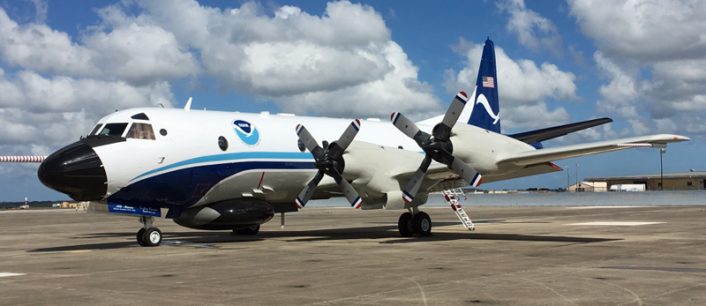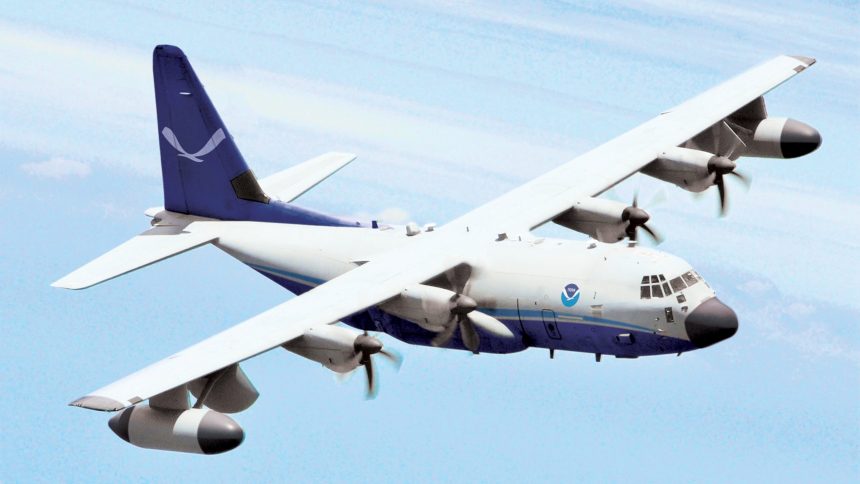NOAA Awards Lockheed Martin Contract for Next-Generation C-130J Hurricane Hunter Aircraft
On Sept. 27, 2024, the National Oceanic and Atmospheric Administration (NOAA) announced a major step forward in its hurricane reconnaissance capabilities by awarding a contract to Lockheed Martin Aeronautics for the development of two specialized C-130J Hercules aircraft. These aircraft, which will be built in Georgia, are set to become the next generation of NOAA’s renowned hurricane hunter fleet. With their four-engine design and extensive modifications, the new planes will serve as flying laboratories, playing a critical role in supporting NOAA’s ongoing hurricane and environmental research.
“NOAA is continuing to make critical investments to help protect lives and property,” said NOAA Administrator Rick Spinrad, Ph.D. “These new aircraft will be filled with state-of-the-art technology developed by NOAA and our partners, greatly enhancing our ability to gather critical data on hurricanes, atmospheric rivers, and our changing climate.”
The news come as NOAA and U.S. Air Force Hurricane Hunters are monitoring Hurricane Helene, that has caused widespread evacuations along Florida’s west coast and is responsible for significant flooding and power outages in the region. The storm made landfall after intensifying in the Gulf of Mexico, bringing life-threatening storm surges, heavy rainfall, and damaging winds to parts of the state. The aircraft have been flying missions into the storm to gather critical data, including flights over the eye to collect atmospheric measurements. This information helps improve the accuracy of forecasts related to the storm’s intensity and track, providing valuable insights for meteorologists and emergency responders.
Modernizing Hurricane Hunting with State-of-the-Art Technology
Funded in part by the 2023 Disaster Relief Supplemental Appropriations Act, the two C-130J aircraft are expected to join NOAA’s fleet by 2030. They will replace the aging WP-3D Orions, which have been in service since the mid-1970s. The new planes will come equipped with advanced technology and instrumentation to ensure NOAA remains at the forefront of hurricane forecasting and environmental research.
The contract covers the acquisition of two C-130J Hercules aircraft, as well as NOAA-specific design modifications. Lockheed Martin’s platform will be customized to accommodate larger science payloads and upgraded with a variety of cutting-edge tools, many of which are developed from the experience gained with the WP-3D Orion aircraft.

Key Upgrades and Capabilities
The C-130Js will carry an array of advanced equipment, including the same Multi-Mode Radar system used on the current P-3 aircraft, automated dropsonde launchers, and vertically scanning Doppler radar for more precise data collection. In addition, the planes will feature high-speed internet connectivity and various instrument ports designed for research on surface winds, oceanographic conditions, and atmospheric measurements. These modifications will enhance NOAA’s ability to monitor and understand extreme weather events.
Notably, the new aircraft will also have the capability to launch and control uncrewed aircraft systems (UAS). These drones will expand NOAA’s reach into areas of hurricanes and other storm environments that are otherwise inaccessible, providing vital data for forecasting and research. This capability marks a significant leap in NOAA’s ability to gather data from previously under-measured areas.
These upgrades are crucial tools that directly improve forecasting accuracy. When data from aircraft are available, NOAA’s forecasts for hurricane track accuracy improve by 15-20%, and intensity forecasts are enhanced by 10-15%. These improvements can have life-saving implications, especially as coastal populations grow and evacuation decisions require longer lead times. The next generation of hurricane hunter aircraft will play a vital role in providing communities and decision-makers with the timely, accurate information needed to prepare for and respond to extreme weather events.
“Adding these highly capable C-130J aircraft to our fleet ensures NOAA can continue to provide the public, decision-makers, and researchers with accurate, timely, and life-saving information about extreme weather events,” said Rear Adm. Chad Cary, director of the NOAA Commissioned Officer Corps and NOAA Marine and Aviation Operations. “NOAA is using our more than 50 years of experience gathering data on hurricanes and other atmospheric phenomena to enhance the capabilities of these specialized new aircraft.”
A Legacy of Excellence with Expanded Mission Capabilities
The C-130Js are set to continue the proud legacy of NOAA’s WP-3D Orions, which have supported hurricane and severe weather research for nearly five decades. These new aircraft will not only advance hurricane forecasting but will also support a wide array of environmental research efforts, including tornado studies, atmospheric rivers research, satellite calibration, fire weather monitoring, and pollution tracking.
Additionally, the C-130Js will expand their mission capabilities beyond weather monitoring. The aircraft will support coastal mapping, gravity measurements, and transport capabilities for worldwide deployments. With long-endurance capabilities, the C-130Js will be able to carry out extensive environmental data-gathering missions, enhancing NOAA’s global research and forecasting capabilities.
Managed and operated by NOAA Corps officers and civilian personnel, the new aircraft will ensure NOAA remains a leader in hurricane hunting and environmental research for years to come.
As extreme weather events continue to impact communities worldwide, NOAA’s investment in modernizing its aircraft fleet underscores its commitment to safeguarding lives and property. By equipping its hurricane hunters with state-of-the-art technology, NOAA will continue to deliver critical data that improves weather forecasts, enhances scientific understanding, and helps mitigate the impacts of natural disasters.
The C-130Js will be based at the NOAA Aircraft Operations Center in Lakeland, Florida, alongside the rest of NOAA’s specialized environmental aircraft fleet that includes four distinct airframes (excluding unmanned):
- Two Beechcraft King Air 350 CERs and one King Air 360CER (registration N67RF and N68RF; callsigns NOAA67 and NOAA68; N65RF; callsign NOAA65 respectively), versatile, twin-engine, extended-range turboprop aircraft that primarily support coastal mapping, snow and soil moisture surveys, and emergency response missions.
- Four De Havilland DHC-6-300 Twin Otters (N46RF, N48RF, N56RF, and N57RF, with corresponding callsigns NOAA46, NOAA48, NOAA56, and NOAA57). These are among the most versatile aircraft in NOAA’s fleet. Renowned for their reliability, ability to take off and land on short runways, impressive payload capacity, and excellent external visibility, they are invaluable for supporting NOAA’s scientific missions, even in the most challenging conditions. Alongside the King Airs, they participate in Snow Survey and Soil Moisture research programs. Additionally, the Twin Otters play a key role in conservation efforts, helping to monitor and protect the critically endangered North Atlantic right whale.
- The Gulfstream IV-SP (G-IV), known as “Gonzo” (registration N49RF/NOAA49), is NOAA’s advanced, fast-flying aircraft used for hurricane research and forecasting. This high-tech platform flies around and above developing tropical storms, gathering detailed data on the surrounding upper atmosphere to aid in accurate storm predictions.
- Two Lockheed WP-3D Orions “Kermit” & “Miss Piggy” (N42RF and N43RF, radio callsigns NOAA42 and NOAA43, respectively): they were specifically made, brand-new, by Lockheed for NOAA and first flew in 1975. The aircraft were introduced into service in 1976.









